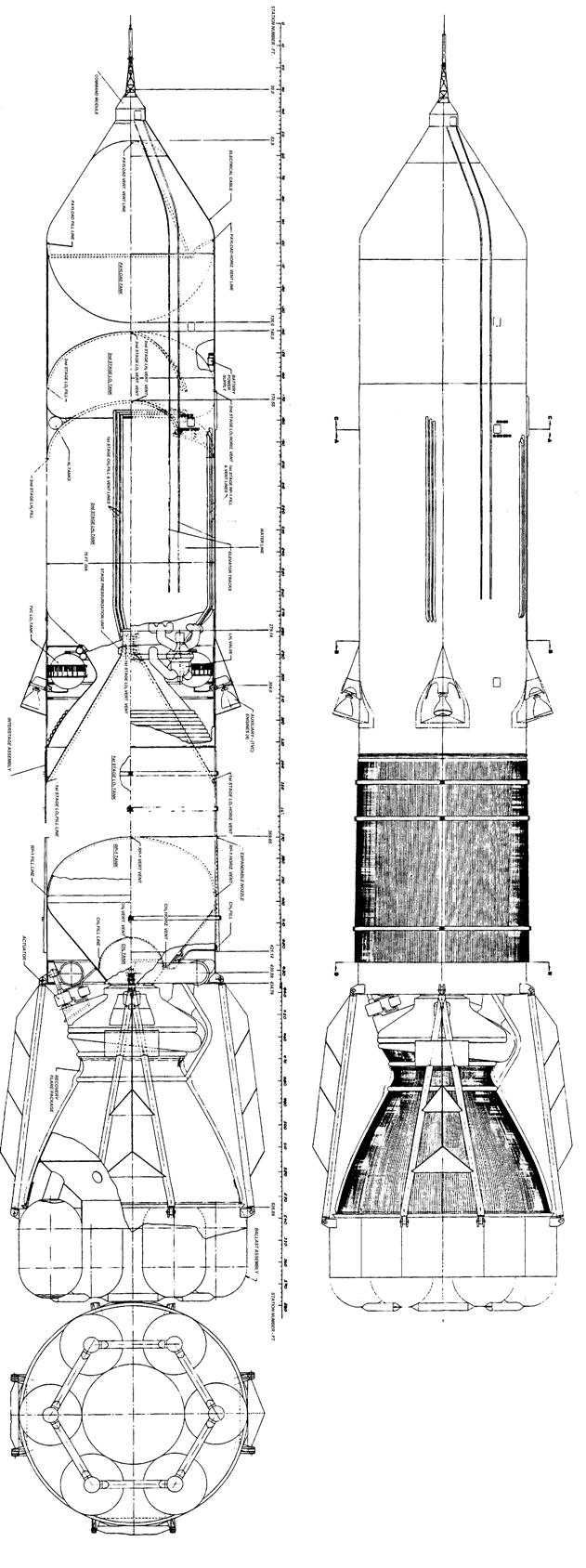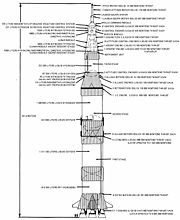
Sea Dragon (Rocket)
Encyclopedia


Rocket
A rocket is a missile, spacecraft, aircraft or other vehicle which obtains thrust from a rocket engine. In all rockets, the exhaust is formed entirely from propellants carried within the rocket before use. Rocket engines work by action and reaction...
. The project was led by Robert Truax
Robert Truax
Captain Robert C. Truax was a rocket engineer in the United States Navy, and companies such as Aerojet and Truax Engineering, which he founded...
while working at Aerojet
Aerojet
Aerojet is an American rocket and missile propulsion manufacturer based primarily in Rancho Cordova, California with divisions in Redmond, Washington, Orange, Gainesville and Camden, Arkansas. Aerojet is owned by GenCorp. They are the only US propulsion company that provides both solid rocket...
, one of a number of designs he created that were to be launched by floating the rocket in the ocean. Although there was some interest at both NASA
NASA
The National Aeronautics and Space Administration is the agency of the United States government that is responsible for the nation's civilian space program and for aeronautics and aerospace research...
and Todd Shipyards
Todd Shipyards
Todd Shipyards was an American soccer club based in Brooklyn, New York that was an inaugural member of the American Soccer League. The team was formed when the Todd Shipyard company decided to merge the Brooklyn Robins Dry Dock with Tebo Yacht Basin F.C....
, nothing ever came of the design as NASA's Future Projects Branch was shut down in the mid-60s. At 150 m long and 23 m in diameter, Sea Dragon would have been the largest rocket ever built.
Truax's basic idea was to produce a low-cost heavy launcher, a concept now called "big dumb booster
Big dumb booster
Big Dumb Boosters are a general class of launch vehicle built around the idea that it is cheaper to mass build and operate a large, strong, heavy rocket of simple design than it is to build a few smaller, lighter, more cleverly-designed ones...
". To lower the cost of operation, the rocket itself was launched from the ocean, requiring little in the way of support systems. A large ballast tank system attached to the bottom of the first-stage engine bell
De Laval nozzle
A de Laval nozzle is a tube that is pinched in the middle, making a carefully balanced, asymmetric hourglass-shape...
was used to "hoist" the rocket vertical for launch. In this orientation the cargo at the top of the second stage was just above the waterline, making it easy to access. Truax had already experimented with this basic system in the Sea Bee and Sea Horse designs. To lower the cost of the rocket itself, he intended it to be built of inexpensive materials, specifically 8 mm steel sheeting. The rocket would be built at a sea-side shipbuilder and towed to sea for launch.
The first stage was to be powered by a single enormous 80000000 pound-forces (355.9 MN) thrust engine burning RP-1
RP-1
RP-1 is a highly refined form of kerosene outwardly similar to jet fuel, used as a rocket fuel. Although having a lower specific impulse than liquid hydrogen , RP-1 is cheaper, can be stored at room temperature, is far less of an explosive hazard and is far denser...
and liquid oxygen
Liquid oxygen
Liquid oxygen — abbreviated LOx, LOX or Lox in the aerospace, submarine and gas industries — is one of the physical forms of elemental oxygen.-Physical properties:...
. The fuels were pushed into the engine
Pressure-fed cycle (rocket)
The pressure-fed cycle is a class of rocket engine designs. A separate gas supply, usually helium, pressurizes the propellant tanks to force fuel and oxidizer to the combustion chamber. To maintain adequate flow, the tank pressures must exceed the combustion chamber pressure.Pressure fed engines...
by an external source of nitrogen
Nitrogen
Nitrogen is a chemical element that has the symbol N, atomic number of 7 and atomic mass 14.00674 u. Elemental nitrogen is a colorless, odorless, tasteless, and mostly inert diatomic gas at standard conditions, constituting 78.08% by volume of Earth's atmosphere...
gas, which provided a pressure of 32 atm for the RP-1 and 17 atm for the LOX, providing a total pressure in the engine of 20 atm (~300 psi) at takeoff. As the vehicle climbed the pressures dropped off, eventually burning out after 81 seconds. By this point the vehicle was 25 miles up and 20 miles downrange (40 km x 33 km), traveling at a speed of 4,000 mph (1.8 km/s). The normal mission profile expended the stage in a high-speed splashdown some 180 miles (290 km) downrange. Plans for stage recovery were studied as well.
The second stage was also equipped with a single very large engine, in this case a 6 million kgf thrust engine burning liquid hydrogen
Liquid hydrogen
Liquid hydrogen is the liquid state of the element hydrogen. Hydrogen is found naturally in the molecular H2 form.To exist as a liquid, H2 must be pressurized above and cooled below hydrogen's Critical point. However, for hydrogen to be in a full liquid state without boiling off, it needs to be...
and LOX. Although also pressure-fed, in this case the nitrogen kept the system running at a constant lower pressure of 7 atm throughout the entire 260 second burn, at which point it was 230 km up and 940 km downrange. To improve performance, the engine featured an expanding engine bell, changing from 7:1 to 27:1 expansion as it climbed. The overall height of the rocket was shortened somewhat by making the "nose" of the first stage pointed, lying inside the second stage engine bell.
A typical launch sequence would start with the rocket being refurbished and mated to its cargo and ballast tanks on shore. The RP-1 and nitrogen would also be loaded at this point. The rocket would then be towed to a launch site, where the LOX and LH2 would be generated on-site using electrolysis
Electrolysis
In chemistry and manufacturing, electrolysis is a method of using a direct electric current to drive an otherwise non-spontaneous chemical reaction...
; Truax suggested using a nuclear-powered aircraft carrier
Aircraft carrier
An aircraft carrier is a warship designed with a primary mission of deploying and recovering aircraft, acting as a seagoing airbase. Aircraft carriers thus allow a naval force to project air power worldwide without having to depend on local bases for staging aircraft operations...
as a power supply during this phase. The ballast tanks, which also served as a cap and protection for the first stage engine bell, would then be filled with water, raising the rocket to vertical. Last minute checks could then be carried out, and the rocket launched.
The rocket would have been able to carry a payload of up to 550 metric tons into low earth orbit
Low Earth orbit
A low Earth orbit is generally defined as an orbit within the locus extending from the Earth’s surface up to an altitude of 2,000 km...
. Payload costs were estimated to be between $59 to $600 per kg, which is much less than today's launch costs. TRW
TRW
TRW Inc. was an American corporation involved in a variety of businesses, mainly aerospace, automotive, and credit reporting. It was a pioneer in multiple fields including electronic components, integrated circuits, computers, software and systems engineering. TRW built many spacecraft,...
conducted a program review and validated the design and its expected costs, apparently a surprise to NASA. However, budget pressures led to the closing of the Future Projects Branch, ending work on the super-heavy launchers they had proposed for a manned mission to Mars.
External links
- FAR
- Search "Sea Dragon Concept" at the NASA Technical Report Server to read the unclassified design study:
- Sea Dragon Concept Volume 1 (Summary), LRP 297 (NASA-CR-52817), 1963-01-28.
- Sea Dragon Concept Volume 3 (Preliminary program plan), LRP 297 (NASA-CR-51034), 1963-02-12.

